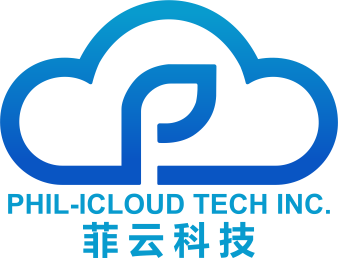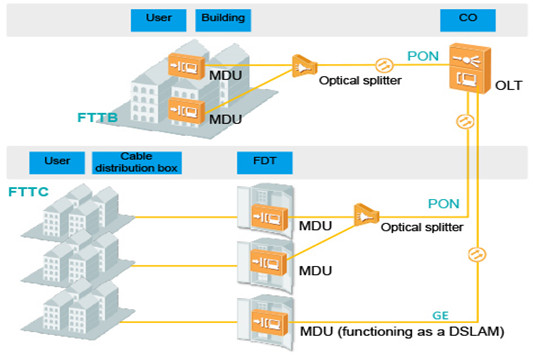FTTB and FTTC Solution Overview
Copper lines are critical infrastructures for fixed network carriers. The construction of ultra-wideband networks using innovative technologies on existing copper lines is being widely accepted by carriers. Although copper lines have been in service for hundreds of years, the application of innovative technologies, such as G.fast and NG-Fast, the copper lines will be able to provide higher and higher bandwidths.
Copper technology will continue with innovation. In addition to vectoring and G.fast, the research on NG-Fast has been started, which will provide a bandwidth of 5–10 Gbit/s over copper lines.

FTTB/FTTC Network Structure
FTTB: indicates fiber to the building. In this scenario, optical fibers are routed from a CO to access devices that locate in buildings, such as in light-current wells or basements. Then, the access devices connect to copper (xDSL) or Cat 5 (LAN) lines that are routed to user homes, implementing service access. FTTB applies to business zones and residential areas with high population densities.
FTTC: indicates fiber to the curb. In this scenario, optical fibers are routed from a CO to access devices that locate at fiber distribution terminals (FDTs) along the curb or in cable distribution compartments/FDTs in residential areas. Then, the access devices connect to copper (xDSL) lines that are routed to user homes, implementing service access. FTTC applies to areas with low population densities.
| Area |
Demand |
Topology |
Access Technology |
Typical Bandwidth |
| High-value area |
High-end users impose
increasingly strong demands
on high bandwidths. |
FTTD
FTTdp
FTTB |
G.fast Vectoring |
100 Mbit/s to 1 Gbit/s |
| Urban area |
Requires quick network
coverage and reuses
existing copper lines. |
FTTB
FTTC
DSLAM |
VDSL2
Vectoring
SuperVector |
30-300 Mbit/s |
| Rural area |
Requires long-distance
network coverage and
reuses existing copper lines. |
FTTB
FTTC
DSLAM |
VDSL2
ADSL2+ |
4-30 Mbit/s |
FTTB/FTTC Typical Networking Topology and Functions
MDUs are deployed in corridors and connect Cat 5 lines to user homes.
- For the Internet access service, users connect to an MDU using Cat 5 lines and are authenticated by dialing a number through PCs. Each user has a separate account. All user accounts are centrally authenticated and managed on the broadband remote access server (BRAS).
- For the voice service, the MDUs embedded with a voice module provide the VoIP service for users.
MDUs are deployed in corridors or FDTs along the curb, and connect twisted pairs to user homes.
- For the Internet access service, users access the Internet at a high speed using the modems deployed at their homes. Modems are Layer 2 devices and therefore require authentication by dialing a number through PCs. Each user has a separate account. All user accounts are centrally authenticated and managed on the BRAS.
- For the voice service, the MDUs embedded with a voice module provide the VoIP service for users.
| Usage Scenario |
Recommended Solution |
General Specifications |
| FTTB (LAN+POTS) |
F01S50/F01C50+MA5620/MA 5626 |
LAN and POTS |
| F01S100+MA5620/MA5626 |
LAN and POTS |
| F01C100B+MA5620/MA5626 |
LAN and POTS |
| FTTB/FTTC (xDSL+POTS) |
F01C100B+MA5616 |
VDSL2/ADSL2+, vectoring, SuperVector and POTS |
| F01S100+MA5616 |
VDSL2/ADSL2+, vectoring, SuperVector and POTS |
| F01S200+MA5616 |
VDSL2/ADSL2+, vectoring, SuperVector and POTS |
| F01T300/F01S300+MA5616 |
VDSL2/ADSL2+, vectoring, SuperVector and POTS |
| F01S50/F01C50/F01C100B+ MA5622A/MA5623A |
VDSL2, VDSL2 combo and vectoring |
| MA5611S series (outdoor devices, which do not require a separate cabinet) |
VDSL2 and vectoring |
Short Time to Market Network upgrade
Outdoor Integrated Access Solution
Access devices are continuously moving downward to be closer to end users. In this case, the devices might be installed outdoor, such as mounted to poles or exterior walls or installed in manholes. The outdoor installation scenarios promote high requirements on environment adaptability and power obtaining for the access devices. Providing a comprehensive outdoor integrated access solution, meeting outdoor installation requirements.
High bandwidth
- 100 Mbit/s access: VDSL2+vectoring
- 1 Gbit/s access: G.fast+vectoring
High environment adaptability
- Outdoor integrated ONU (small form factor-sealed unit)
- Dustproof/Waterproof level: IP68/IP55
Flexible power obtaining
- Local AC power
- Reverse PoE
- Remote power supply (RPS)
Backward Compatible and Future-Oriented SuperVector Speedup
In copper network speedup, various carriers have used VDSL2 + vectoring to achieve 50-100 Mbit/s access. The more advanced G.fast + vectoring solution provides 500 Mbit/s to 1 Gbit/s access at a short distance. However, some carriers require a solution medium to these two solutions. This is SuperVector. On the basis of VDSL2 + vectoring, SuperVector speeds up the copper line rate to 100-300 Mbit/s, which is applicable to broadband coverage for copper line speedup at original sites and remote areas.
Improved bandwidth: Maximum downstream bandwidth is improved from 100 Mbit/s in VDSL2 + vectoring to 300 Mbit/s.
Speedup at long distance: Attainable distance for downstream 100 Mbit/s bandwidth is expanded from about 500 m in VDSL2 + vectoring to 700 m.
Protected site investments: Second speedup at original sites, featuring short TTM and fast return on investment (ROI). This greatly protests carrier investments on FTTC and vectoring sites.

Acronyms and Abbreviations
| BRAS |
broadband remote access server |
CCU |
cabinet control unit |
| DSLAM |
digital subscriber line access multiplexer |
EOS |
end of service |
| FTTB |
fiber to the building |
FTTC |
fiber to the curb |
| FTTD |
fiber to the door |
FTTdp |
fiber to the distribution point |
| FTTH |
fiber to the home |
GE |
gigabit Ethernet |
| GIS |
geographic information system |
HGW |
home gateway |
| IAD |
integrated access device |
IMS |
information management system |
| IPTV |
internet protocol television |
LAN |
local area network |
| MDF |
main distribution frame |
MDU |
multi-dwelling unit |
| NAC |
network analyst center |
NAT |
network address translation |
| NGN |
next generation network |
OLT |
optical line terminal |
| ONU |
optical network unit |
OPEX |
operating expense |
| PE |
provider edge |
PON |
passive optical network |
| POTS |
plain old telephone service |
STB |
set top box |
| TCO |
total cost of ownership |
UPE |
underlayer provider edge |
| xDSL |
x digital subscriber line |
|
|
Contact us











